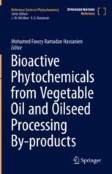Search
Search Results
-
Fatty Acid Composition and Oxidative Potential of Food Products Prepared Using Low Erucic Brassica Oils
Two newly developed low erucic acid containing varieties of Indian mustard (RLC 3) and rapeseed (GSC 7) were evaluated for cooking quality. Oils...

-
Genomic and transcriptome analyses reveal potential contributors to erucic acid biosynthesis in seeds of rapeseed (Brassica napus)
Key messageThrough comprehensive genomic and transcriptomic analyses, we identified a set of 23 genes that act up- or downstream of erucic acid...

-
Bioactive Phytochemicals from Rapeseed (Brassica napus) Oil Processing By-products
Rapeseed oil is currently the third source of vegetable oils. Crude oils generally contain undesirable substances which need to be removed to produce...
-
Improving linolenic acid content in rapeseed oil by overexpression of CsFAD2 and CsFAD3 genes
With the increasing public attention to the health benefit of polyunsaturated fatty acids (PUFAs) and demand for linolenic acid (C18:3), it is of...

-
Nutraceutical Potential of Rapeseed: Breeding and Biotechnological Approaches
Rapeseed (Brassica napus L.) is a prime oil crop of the world that also provides proteins for the livestock feeding. This crop has achieved...
-
Nutraceutical Potential of Rapeseed: Breeding and Biotechnological Approaches
Rapeseed (Brassica napus L.) is a prime oil crop of the world that also provides proteins for the livestock feeding. This crop has achieved...
-
Chemical Transformations of Fatty Acids in the Hydrolysis of Triglycerides. Selective Isolation of Oleic Acid from Rapeseed Oil under Sub- and Supercritical Water Conditions
AbstractThe hydrolysis of rapeseed oil in sub- and supercritical water ( T = 573–653 K, p = 30 MPa) has been studied using a batch setup. Unlike...

-
Mutagenesis Breeding for Drought-Tolerance and Improvement of Oil and Seed Quality in Oilseed Crops: Case of Rapeseed and Sesame
Nowadays, world food security is more and more threatened by the extreme events caused by climate change associated with the increasing population....
-
Foliar Application of Growth Regulators Mitigates Harmful Effects of Drought Stress and Improves Seed Yield and Oil Quality of Rapeseed (Brassica napus L.)
This study aimed to investigate the effect of plant growth regulators (PGRs) for improving the quantity and quality of rapeseed oil under different...

-
Cultivars and oil extraction techniques affect Cd/Pb contents and health risks in oil of rapeseed grown on Cd/Pb-contaminated farmland
Substitute planting with rapeseed offers promise for safely using large areas of Cd/Pb-contaminated farmland. Cd/Pb distributions during rapeseed oil...

-
A Study of the Possibility of Carrying out Chemical Reactions during the Synthesis of Azelaic Acid Di(2-ethylhexyl) Ester Based on Rapeseed Oil under Supercritical Conditions
AbstractThe chemical stages of the process of preparation of azelaic acid di(2-ethylhexyl) ester from rapeseed oil are studied—the reactions of...

-
Bioactive Phytochemicals from Rapeseed (Brassica napus) Oil Processing By-products
Rapeseed oil is currently the third source of vegetable oils. Crude oils generally contain undesirable substances which need to be removed to...
-
Effects of rapeseed oil on body composition and glucolipid metabolism in people with obesity and overweight: a systematic review and meta-analysis
To investigate the effects of rapeseed oil on body composition, blood glucose and lipid metabolism in people with overweight and obesity compared to...

-
Seed Development, Oil Accumulation and Fatty Acid Composition of Drought Stressed Rapeseed Plants Affected by Salicylic Acid and Putrescine
Two field experiments were carried out in 2017 and 2018 to evaluate the impacts of salicylic acid (1 mM SA) and putrescine (1 mM Put) on leaf...

-
Advanced Breeding for Oil and Oil Cake Quality in Brassica juncea
Mustard oil is a storehouse of essential fatty acids, linoleic acid and linolenic acid. However, its oil is still not considered good for health by...
-
Integrated Effects of Nitrogen Fertilizer, Biochar, and Salicylic Acid on Yield and Fatty Acid Profile of Six Rapeseed Cultivars
This study was conducted to evaluate the effect of nitrogen fertilizer with biochar and foliar application of salicylic acid on physiological traits,...

-
Low CO2 concentration, a key environmental factor for develo** plateau adapted rapeseed
BackgroundPhotosynthesis is a fundamental process that underlies the formation of crop yield, wherein light serves as the driving force and carbon...

-
Application of Silicon for Improving Some Physiological Characteristics, Seed Yield, and Oil Quality of Rapeseed Genotypes Under Late-Season Drought Stress
Drought stress is one of the most important factors in reducing yield and seed quality of rapeseed. Therefore, in this study, several new rapeseed...

-
Canola Oil as a Bio-additive: Properties, Processing and Applications
In recent years, vegetables and plant-based edible oils have received a lot of attention owing to the presence of high amounts of mono-, and...
-
Effect of Potassium Silicate on Seed Yield and Fatty Acid Composition of Rapeseed (Brassica napus L.) Genotypes Under Different Irrigation Regimes
Abiotic stresses such as water deficit conditions reduce crop performance. Potassium silicate can alleviate adverse effects of water deficit stress...
